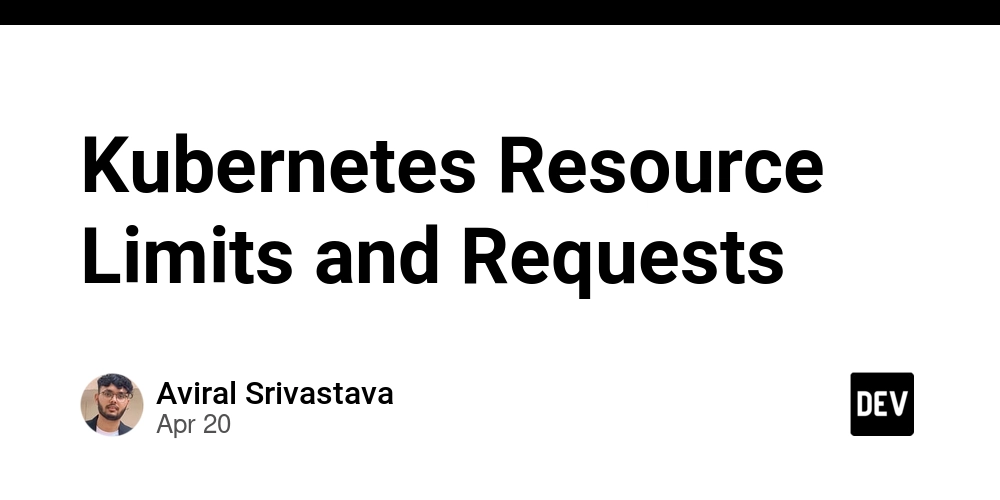Kubernetes Resource Limits and Requests
Kubernetes Resource Limits and Requests: Managing Container Resources Introduction: Kubernetes provides mechanisms to control resource allocation for containers: resource limits and requests. These settings define the maximum and minimum resources a container can consume, ensuring fair resource sharing among pods within a cluster. This article explores these crucial concepts. Prerequisites: Understanding basic Kubernetes concepts like pods, deployments, and resource units (CPU, memory) is necessary. Familiarity with YAML configuration is also helpful. Resource Requests and Limits: Resource requests specify the minimum amount of resources a container needs to function correctly. Kubernetes schedulers use requests to guarantee resource allocation during pod scheduling. Resource limits specify the maximum amount of resources a container can consume. Exceeding limits might lead to throttling or eviction. Example: apiVersion: v1 kind: Pod metadata: name: my-pod spec: containers: - name: my-container image: my-image resources: limits: cpu: "2" memory: "4Gi" requests: cpu: "1" memory: "2Gi" This example specifies a request of 1 CPU and 2 GiB of memory, and a limit of 2 CPUs and 4 GiB of memory. Advantages: Improved Resource Utilization: Prevents resource hogging by limiting container consumption. Predictable Performance: Guarantees minimum resource allocation, preventing performance degradation. Enhanced Cluster Stability: Prevents overcommitment and reduces the chance of cluster instability. Fair Resource Sharing: Ensures equitable resource distribution among pods. Disadvantages: Increased Complexity: Requires careful resource planning and monitoring. Potential for Resource Waste: Setting limits too high can lead to unused resources. Potential for OOMKilled processes: If a container exceeds its memory limit, it might be killed by the kernel. Features: Resource requests and limits can be specified for CPU and memory. They apply at the container level. Kubernetes uses these settings for scheduling, resource allocation, and eviction policies. Conclusion: Effective resource planning using Kubernetes resource requests and limits is crucial for maintaining stable and performant clusters. Carefully defining these limits and requests based on application requirements will lead to optimized resource utilization and a more robust Kubernetes environment. Continuous monitoring and adjustment are vital to refine these settings over time.

Kubernetes Resource Limits and Requests: Managing Container Resources
Introduction:
Kubernetes provides mechanisms to control resource allocation for containers: resource limits and requests. These settings define the maximum and minimum resources a container can consume, ensuring fair resource sharing among pods within a cluster. This article explores these crucial concepts.
Prerequisites:
Understanding basic Kubernetes concepts like pods, deployments, and resource units (CPU, memory) is necessary. Familiarity with YAML configuration is also helpful.
Resource Requests and Limits:
Resource requests specify the minimum amount of resources a container needs to function correctly. Kubernetes schedulers use requests to guarantee resource allocation during pod scheduling. Resource limits specify the maximum amount of resources a container can consume. Exceeding limits might lead to throttling or eviction.
Example:
apiVersion: v1
kind: Pod
metadata:
name: my-pod
spec:
containers:
- name: my-container
image: my-image
resources:
limits:
cpu: "2"
memory: "4Gi"
requests:
cpu: "1"
memory: "2Gi"
This example specifies a request of 1 CPU and 2 GiB of memory, and a limit of 2 CPUs and 4 GiB of memory.
Advantages:
- Improved Resource Utilization: Prevents resource hogging by limiting container consumption.
- Predictable Performance: Guarantees minimum resource allocation, preventing performance degradation.
- Enhanced Cluster Stability: Prevents overcommitment and reduces the chance of cluster instability.
- Fair Resource Sharing: Ensures equitable resource distribution among pods.
Disadvantages:
- Increased Complexity: Requires careful resource planning and monitoring.
- Potential for Resource Waste: Setting limits too high can lead to unused resources.
- Potential for OOMKilled processes: If a container exceeds its memory limit, it might be killed by the kernel.
Features:
- Resource requests and limits can be specified for CPU and memory.
- They apply at the container level.
- Kubernetes uses these settings for scheduling, resource allocation, and eviction policies.
Conclusion:
Effective resource planning using Kubernetes resource requests and limits is crucial for maintaining stable and performant clusters. Carefully defining these limits and requests based on application requirements will lead to optimized resource utilization and a more robust Kubernetes environment. Continuous monitoring and adjustment are vital to refine these settings over time.









































































































































































![[The AI Show Episode 144]: ChatGPT’s New Memory, Shopify CEO’s Leaked “AI First” Memo, Google Cloud Next Releases, o3 and o4-mini Coming Soon & Llama 4’s Rocky Launch](https://www.marketingaiinstitute.com/hubfs/ep%20144%20cover.png)



























































































































![[DEALS] The All-in-One Microsoft Office Pro 2019 for Windows: Lifetime License + Windows 11 Pro Bundle (89% off) & Other Deals Up To 98% Off](https://www.javacodegeeks.com/wp-content/uploads/2012/12/jcg-logo.jpg)




























![Is this too much for a modular monolith system? [closed]](https://i.sstatic.net/pYL1nsfg.png)






















































































































_Andreas_Prott_Alamy.jpg?width=1280&auto=webp&quality=80&disable=upscale#)





























































































![What features do you get with Gemini Advanced? [April 2025]](https://i0.wp.com/9to5google.com/wp-content/uploads/sites/4/2024/02/gemini-advanced-cover.jpg?resize=1200%2C628&quality=82&strip=all&ssl=1)













![Apple Shares Official Trailer for 'Long Way Home' Starring Ewan McGregor and Charley Boorman [Video]](https://www.iclarified.com/images/news/97069/97069/97069-640.jpg)
![Apple Watch Series 10 Back On Sale for $299! [Lowest Price Ever]](https://www.iclarified.com/images/news/96657/96657/96657-640.jpg)
![EU Postpones Apple App Store Fines Amid Tariff Negotiations [Report]](https://www.iclarified.com/images/news/97068/97068/97068-640.jpg)
![Apple Slips to Fifth in China's Smartphone Market with 9% Decline [Report]](https://www.iclarified.com/images/news/97065/97065/97065-640.jpg)



































































































































